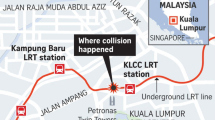Summary
On 3 June 1998 a high-speed train (Inter City Express, ICE) collided with a bridge at a speed of 200 km/h. The bridge collapsed and the rear wagons of the train were pushed into it with the power of the rear engine. The accident caused 101 deaths and 103 injuries. Four minutes after the accident the alarm was raised, and 16 minutes after the accident the first doctor was on the scene, arriving from Celle, approx. 20 km away.
In the first 4 hours after the crash 1844 people from different organisations were at the site of the accident; 461 of these were ambulance personnel and paramedics. 39 aircraft (incl. helicopters and army aircraft) were available at the scene. Many passengers with multiple injuries were stuck in the train and had to be rescued from the severely damaged wagons. Nevertheless all patients with one exception were on the way to hospitals or in the trauma centers 2 hours after accident. 95 passengers passed away on site. The casualties were distributed among 22 hospitals, 2 of them had to be transferred to other hospitals later on for medical reasons. This speaks for the correct selection of hospitals. There were many reasons for the quick rescue and the success of Eschede, namely good weather conditions, the time of the accident (normal working day) the availability of rescue by air, the great number of doctors, ambulance personnel, paramedics and search and rescue teams on site, as well as the excellent cooperation between the different organisations, mainly fire brigades, police, army, border patrol, technical assistance teams and search and rescue coordinators).
Zusammenfassung
Am 03.06.1998, 10.59 Uhr verunfallte ein ICE-Zug bei einer Geschwindigkeit von 200 km/h. Durch eine eingestürzte Brücke wurden die Wagen teilweise ziehharmonikaartig durch den hinteren Triebkopf zusammengequetscht. Die Zahl der Toten betrug 101, 103 Personen wurden verletzt. 4 Minuten nach dem Unfallereignis wurde Alarm gegeben und 16 Minuten nach dem Unfall traf der 1. Notarzt aus dem ca. 20 km entfernten Celle ein. In den ersten 4 Stunden nach dem Unfallgeschehen kamen aus den unterschiedlichsten Organisationen 1.844 Personen zum Einsatz, davon 467 aus dem Rettungs- und Sanitätsdienst. 39 Luftfahrzeuge standen an der Unfallstelle zur Verfügung. Die eingeklemmten Schwerverletzten mußten z. T. mühevoll aus zertrümmerten Wagen befreit werden, dennoch befanden sich alle Patienten um 12.55 Uhr mit einer Ausnahme auf dem Weg in die Kliniken. Die Verletzten wurden dezentral auf insgesamt 22 Kliniken verteilt. 95 wurden tot an der Unfallstelle geborgen. 2 Patienten wurden aus medizinischer Indikation verlegt. Dies spricht für eine korrekte Auswahl der Zielkrankenhäuser. Für die schnellen Rettungszeiten und den Erfolg in Eschede waren neben den günstigen äußeren Umständen wie klare Sicht, Zeitpunkt des Unfallgeschehens, Einsatz der Luftrettung, die große Zahl von Notärzten, Rettungs- und Sanitätspersonal und das hervorragende Zusammenwirken der verschiedenen Organisationen, insbesondere der Feuerwehr, des technischen Hilfswerks, der Bundeswehr, der Polizei, des Bundesgrenzschutzes und der Katastropheneinsatzleitung entscheidend.
Similar content being viewed by others
Author information
Authors and Affiliations
Rights and permissions
About this article
Cite this article
Oestern, H., Hüls, E., Quirini, W. et al. Facts concerning the Eschede disaster. Unfallchirurg 101, 813–816 (1998). https://doi.org/10.1007/s001130050344
Published:
Issue Date:
DOI: https://doi.org/10.1007/s001130050344




